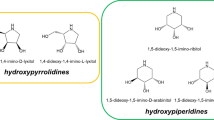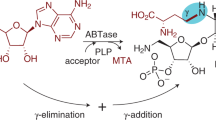Abstract
2-DEOXY D-ribose is of considerable importance since it is the carbohydrate constituent of the de-oxyribonucleic acid of cell nucleal material, and we have been interested in its preparation for structural and synthetic studies. Although we have made some improvements in the standard method of its synthesis from D-arabinal, we are exploring alternative routes. A possible method resulted from the work of Newth, Overend and Wiggins1 on the ring scission of 2 : 3-anhydro 4 : 6-benzylidene α-methyl alloside (I) with halogen acids, because hydrobromic acid in aqueous acetone solution effected scission of the anhydro ring in this substance to give 2-bromo α-methyl altroside (one part) and 3-bromo α-methyl glucoside (4 parts). On this finding it was clear that a similar ring scission of 2 : 3-anhydro β-methyl D-riboside (II) would give rise to 2-bromo β-methyl D-arabinoside (III) and 3-bromo β-methyl D-xyloside (IV), although it is our experience2 that, as yet, it would be inexpedient to predict the relative proportions of the isomers that could be produced in this reaction. The halogen sugars (III) and (IV) on reductive dehalogenation would afford 2-deoxy β-methyl D-riboside (arabinoside) and 3-deoxy β-methyl D-riboside (xyloside). Thus if 2-bromo β-methyl D-arabinoside (III) was the main product of the ring-opening of 2 : 3-anhydro β-methyl D-riboside, this procedure would furnish a new method of preparation of 2-deoxy β-methyl D-riboside and of 2-deoxy D-ribose itself. We have found, however, that (III) was only the minor constituent of the ring-scission products, 3-bromo β-methyl D-xyloside being the main product. We have, however, obtained 2-deoxy β-methyl D-riboside and 2-deoxy D-ribose by this procedure, although the method clearly has no preparative value.
This is a preview of subscription content, access via your institution
Access options
Subscribe to this journal
Receive 51 print issues and online access
$199.00 per year
only $3.90 per issue
Buy this article
- Purchase on Springer Link
- Instant access to full article PDF
Prices may be subject to local taxes which are calculated during checkout
Similar content being viewed by others
References
Overend, W. G., Newth, F. H., and Wiggins, L. F., J. Chem. Soc., 10 (1947).
Wiggins, L. F., unpublished results.
Honeyman, J., J. Chem. Soc, 790 (1946).
Dische, Z. Microchem., 8, 4 (1930).
Deriaz, R. E., Stacey, M., Teece, E. G., and Wiggins, L. F., unpublished results, and Nature, 157, 740 (1946).
Todd, A. R., private communication, and Mukhergee, S., and Todd, A. R., J. Chem. Soc, 972 (1947).
Author information
Authors and Affiliations
Rights and permissions
About this article
Cite this article
KENT, P., STACEY, M. & WIGGINS, L. Conversion of D-Arabinose into 2-Deoxy D-Ribose and 3-Deoxy D-Xylose. Nature 161, 21–22 (1948). https://doi.org/10.1038/161021a0
Issue Date:
DOI: https://doi.org/10.1038/161021a0
This article is cited by
Comments
By submitting a comment you agree to abide by our Terms and Community Guidelines. If you find something abusive or that does not comply with our terms or guidelines please flag it as inappropriate.



